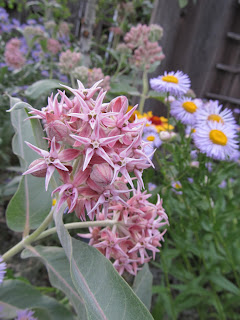In May I started an insect collection. I simply wanted to document all the insects in our garden. Apart from our vegetable garden we have landscaped our yard with plants native to the Missoula area, we have over 100 species, and we don't water any of it. More than 60 species of birds have used the yard, and annually three species of birds nest in our nest boxes. I figured with all this diversity, it would be interesting to collect, document and learn about all the insects that come here too.
I got my inspiration from this from various sources, including Douglas Tallamy's papers and books, and my friend Jen who is starting the Missoula Butterfly House and Insectarium.
I have taken a couple of entomology classes in college (aquatic and terrestrial) and I thought I knew the deal. I was wrong. I had no idea how much diversity there was, and how interesting so many of these insects are. I have now refined my collection to mainly flies (Diptera), bees, wasps and such (Hymenoptera), beetles (Coleoptrea), some moths (Lepidoptera), bugs (Hemiptera), and grasshoppers (Orthoptera). I'm not even really collecting butterflies (I'm not that great at preserving them), dragon and damsel flies (Odonata- I'm not very good at catching them), really tiny things (not good at mounting them), and nocturnal insects (I'm diurnal). Despite these various limitations and restrictions, I have collected well over 150 species of insects, and the summer is only half over.
Through all this, the thing that has stood out as the most interesting is all the mimics. Beetles that are hairy and imitate bumblebees, flies that mimic wasps, moths that mimic yellow jackets, bees that mimic wasps, and so on. So far, I have collected over 20 genera of these mimics and as the summer continues I am sure there will be many more.
At the top of the post is one of my favorite yellow jacket mimics- it is actually a flower fly (Spilomaya sp.). It does such a good job mimicking a yellow jacket that its deception is nearly complete. It flies like a yellow jacket, in flight it extends its front legs- these have black fronts that make it appear to have longer antennae, like a yellow jacket. The wings have a dark leading edge, that give it the appearance of a yellowjacket at rest folding its two sets of wings (like bees and wasps have), but it only has one (like any fly).
The insect below is a moth- a poplar clearwing moth (Sesia tibialis) that mimics a yellow jacket. It is very convincing- as its name suggests, its wings are clear to complete the mimicry. I was fooled at first, too. The first time I saw one in our garden, it was crawling out of the ground at the base of one of our decadent quaking aspen (Populus tremuloides), and its wings had not expanded yet. I thought for sure it was some solitary ground nesting yellow jacket or hornet, so I gave it its space. I kept a eye on it, and the closer I looked, the more I realized it was not a yellow jacket at all, but a moth.
Adult poplar clearwing moths lay their eggs in the cracks or crevasses of stressed popular, aspen and willow species, and similar to the poplar borers in our garden (Saperda calcarata), the larvae of the clearwing moth bore into the tree- pushing out sawdust and feed for a couple of years before they emerge.
This is another fascinating chapter in the aspen ecology story I have been telling as I track the aspen in our garden (click here, here and here for more information.
It is really only when you see its face, you recognize how harmless the moth is.
Now that I am paying attention I see so much more than I ever knew was out there. I have learned so much and have a new appreciation for insects, their life histories, and the importance your garden can have.





































